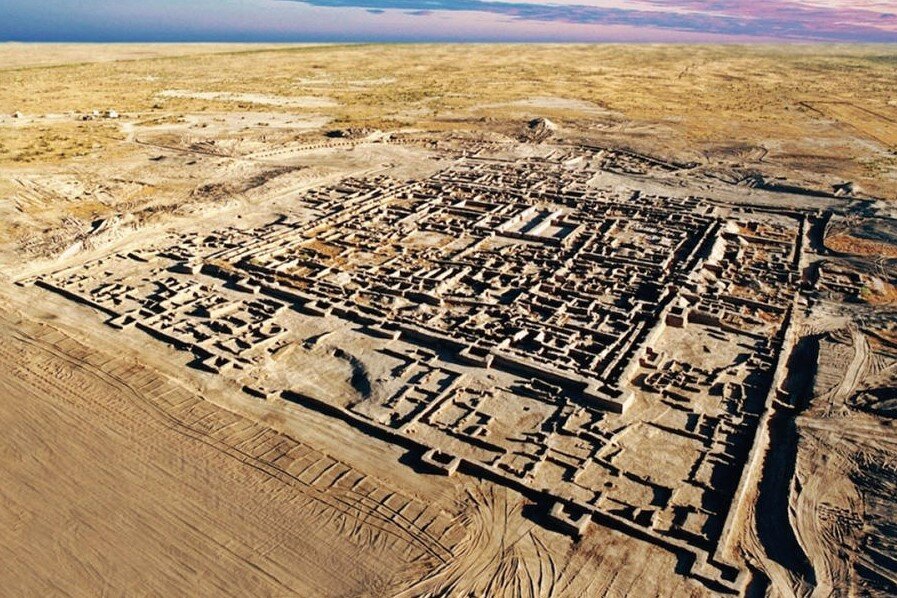Margush – Margiana
Between 1991 and 2001, Italian experts from the Legabue Research Center in Venice, led by Professor Gabriel Rossi-Osmidaniñ, carried out excavations at the monuments in Margiana, together with Turkmen colleagues led by Sarianidini.
Archaeological excavations in the Mary region have led to the discovery of the remains of the ancient city of Merv, which is estimated to be 2.5,000 years old. However, after the study of Margus, it was determined that it was much earlier than the Eric Fortress. Before Margus, these places were called Maury, “the land of abundance,” according to Persian inscriptions, and the Oña natives meant strong, fertile, and fertile land. The name Margusyñ was given to the army of the Greek commander Alexander the Great (Alexander the Great) in the 4th century B.C., when Mervi was conquered and its former name was Greekized as Margiana or Margiana Alexandria.
The first settlers on the Murgaby River were sedentary farmers. The remains of the margus pottery fossils and the images in them provide information about the presence of agriculture and farming in the area. The presence of temple fountains and other water fountains in the temples of Göñurdepe testifies to the construction of aqueducts here, the extraction of water and rainwater from the city, and the storage of large quantities of water in the ponds. Extensive excavations have unearthed evidence of the development of the country’s arts and crafts during the Copper Age in Margiana. Here they mastered the smelting and adjustment of iron, and they made seals, cosmetics, jewelry, and religious jewelry made of copper, copper, gold, and silver. The bones and stones were skillfully carved and the pottery was handled perfectly. Remains of pottery orbs have been found in all the sites of Margus. Structure of spheres: A rectangular or long hole is dug in the ground, and the inside is carved with raw bricks. The oars had holes in which wood was laid, and on top of them were shovels, on which were baked goods.
Cookware doesn’t come into direct contact with the fire when cooking; As a result, they don’t bury or build up. The ancient craftsmen of the Pottery Arts did not make the pottery with handles, and the pottery was poorly decorated with embroidery. The Potters focused on intricate designs. The vases were inscribed with personal seals, and the bow and arrow were carved. Nine of the eight stars are drawn in the bouquet. Blacksmiths made spears, axes of various kinds, and gold ornaments. A gold necklace hanging from the neck of the deceased was found in one of the tombs, and the head of the serpent hangs dangling from it, and it is very delicately made.
The finds found at Goñurdepe indicate that the area was more developed in the area of jewelry. A variety of human and animal sculptures, haircuts, and iññews have been found. The land of Margus is very far from the mountains, but the local stone-cutters did not suffer from a shortage of raw cattle. A variety of white marble stones, such as alebaster, red hake, agate, blue lazurite, and blue marble, were used. These stones were imported from the Allies.
Archaeologists and scholars have proven that Margus had an añ-knowledge. The fact that there is architecture in the world here is itself a reflection of the concept of a particular area. Correspondence was a necessity. More than 20 woods have been found in the interior of the five gates leading to the inner fortress in Goñur, which belong to the Goñurs themselves. Writing was an invention, but it was stymied by the influence of Assyrian calligraphy during the Assyrian march in the 1st millennium BC. In the middle of the same century, when Margiana was incorporated into the Achaemenid state, it was replaced by the ancient Persian pahna script. The monuments of art and architecture bear witness to the existence of science and culture here. Margush is known as the land of birds and bouquets.
Gonurdepe
Gonurdepe is the capital of ancient Margush. In Greek and Roman chronicles, she is called Margiana. The largest city in Central Asia ruled during the Copper Age (late 3rd century to mid-2nd millennium BC). It is a clear symbol of the deep-seated roots of the Turkmen people. Scientists from around the world confirm that our ancient patriarchs created great civilizations. Located in the middle of the night, Margush is one of the top five centers of world culture, along with Ancient Egypt, India, China, and Mesopotamia. International relations in the field of trade and culture were developed here.

